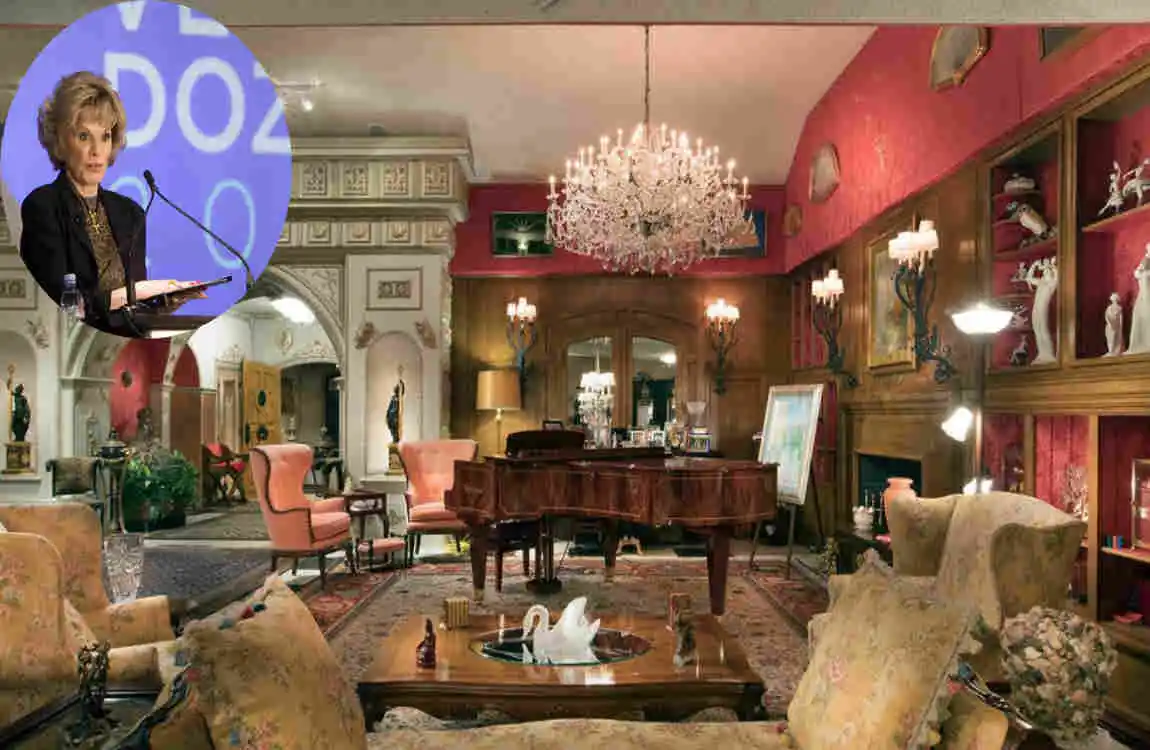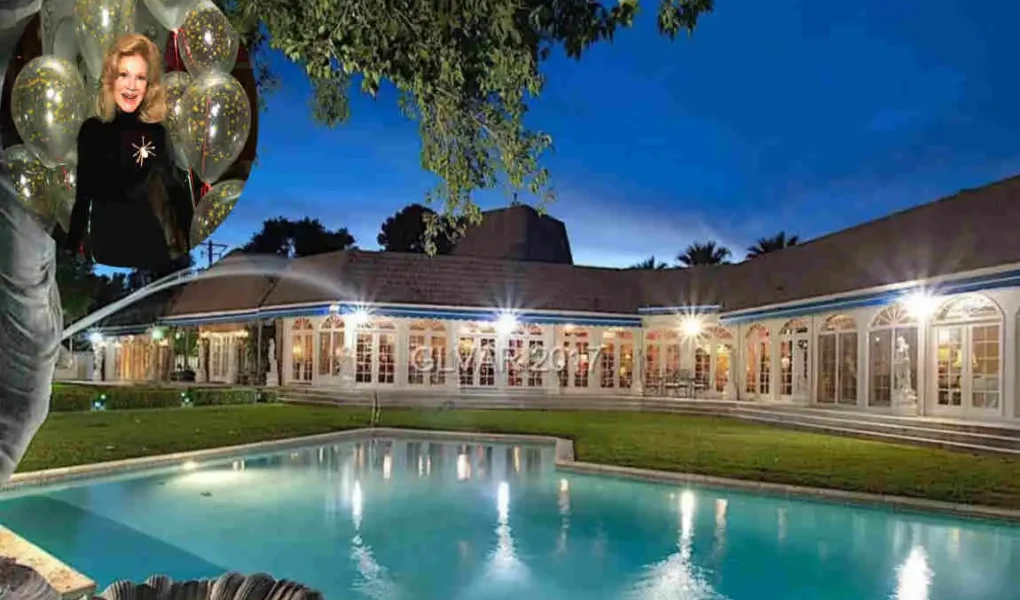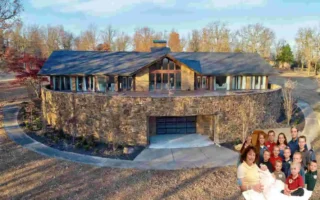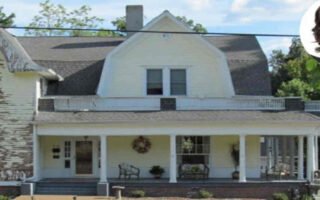Step into a world where glamour meets grandeur, where every corner tells a story of Las Vegas’s golden age. The Phyllis McGuire house stands as a testament to an era when entertainers lived like royalty and homes were built to dazzle. This isn’t just another celebrity mansion—it’s a piece of living history that captures the essence of Vegas luxury.
| Category | Information |
|---|---|
| Full Name | Phyllis McGuire |
| Birth Year | 1931 |
| Death | Died December 29, 2020, at age 89 |
| Nationality | American |
| Profession | Singer (Youngest member of the McGuire Sisters singing trio popular in the 1950s and 1960s) |
| Marital Status | Married and divorced once (No children) |
| Famous Relationships | Affair with mobster Sam Giancana; later relationship with Las Vegas casino owner Bob Stupak |
| Net Worth | Estimated from oil investments, royalties, and valuable assets including jewels, art, mansion, and furnishings |
| Mansion Details | 26,000 sq ft mansion in Rancho Circle, Las Vegas, featuring a 44-foot Eiffel Tower replica, bulletproof windows, and extensive luxury amenities |
| Current Residence | Lived in the Las Vegas mansion until her death in 2020 |
Have you ever wondered what it was like to live at the height of Las Vegas’s entertainment boom? The Phyllis McGuire house offers us a glimpse into that extraordinary world. From its sprawling estate grounds to its meticulously designed interiors, this property represents more than just real estate—it embodies the dreams and aspirations of one of America’s most beloved entertainers.
History of the Phyllis McGuire House

The McGuire Sisters’ Rise to Fame
Before we can truly appreciate this magnificent home, we need to understand the woman who made it famous. Phyllis McGuire wasn’t just any entertainer—she was one-third of the legendary McGuire Sisters, a vocal group that dominated the American music scene in the 1950s and 1960s.
The sisters—Christine, Dorothy, and Phyllis—began their journey in small-town Ohio. Their harmonious blend and wholesome image quickly caught the attention of major record labels. By the mid-1950s, they were topping charts with hits like “Sincerely” and “Sugartime.” Their success wasn’t just musical; they became cultural icons, representing the ideal of American femininity and grace.
Phyllis, the youngest of the trio, possessed a magnetic personality that drew people to her. She had a flair for the dramatic and a love for the finer things in life. This combination would eventually lead her to create one of Las Vegas’s most spectacular private residences.
Building a Dream Home
The Phyllis McGuire house was built in 1967, during what many consider the golden age of Las Vegas entertainment. This wasn’t a time for modest living—entertainers who performed on the Strip lived like the stars they were. Phyllis commissioned the house to be a reflection of her success and her larger-than-life personality.
The timing was perfect. Las Vegas in the 1960s was experiencing unprecedented growth. The city had transformed from a desert outpost to an entertainment capital. Frank Sinatra, Dean Martin, and other members of the Rat Pack were making Vegas their playground. In this atmosphere of excess and excitement, Phyllis McGuire decided to build a home that would rival any palace.
She worked closely with architects to ensure every detail matched her vision. The house needed to be more than just a place to live—it had to be a showpiece that could host the elite of entertainment society. No expense was spared in bringing this vision to life.
Architectural Vision and Design Philosophy
The original design of the house drew inspiration from multiple sources. French Provincial elements mixed with modern luxury created a unique aesthetic that was both timeless and contemporary. The architects understood that this home needed to make a statement while still providing comfort and functionality.
What set this project apart was Phyllis’s personal involvement in every aspect of the design. She didn’t just approve blueprints—she actively participated in choosing materials, colors, and decorative elements. Her background as a performer influenced many decisions, from the acoustics of specific rooms to the dramatic lighting throughout the property.
The house was designed to flow seamlessly from public to private spaces. Grand entertaining areas could accommodate hundreds of guests, while intimate corners provided refuge from the spotlight. This dual nature perfectly reflected Phyllis’s life as both a public figure and a private individual.
Location and Setting
A Prime Vegas Address
| Aspect | Details |
|---|---|
| Specifications | Approximately 26,000 – 38,823 sq. ft., 5-7 bedrooms, 10-12 bathrooms, two dining rooms, chef’s kitchen |
| Architectural Design | Unique mansion featuring a 44-45 ft replica of the Eiffel Tower rising through the center; French theme with elements like an Arc de Triomphe entry and classical statues; ballroom, basement disco, cabaret lounge, bar areas, bulletproof windows, electric shutters |
| Additional Features | Two swimming pools, lagoon, tennis court, detached billiards room, large guest house, Phyllis’s Place with soda fountain, ice cream bar, and grill |
| Worth | Listed around $6.5 million |
| Address | Two-acre parcel in Rancho Circle, Las Vegas, Nevada |
| History | Home of Phyllis McGuire, last living member of the McGuire Sisters, famous for hosting major stars and large gatherings in the 1960s. The house reflects her love for Paris and entertainment lifestyle. |
The Phyllis McGuire house sits in one of Las Vegas’s most exclusive neighborhoods. Located in the prestigious Rancho Circle area, the property enjoys a position that’s both central and secluded. This wasn’t a random choice—Phyllis specifically selected this location for its perfect balance of accessibility and privacy.
You may also read (inside the glamorous life andy cohens hamptons house).
Rancho Circle has long been home to Vegas’s elite. The neighborhood developed in the 1950s and quickly became the address of choice for entertainers, casino executives, and other prominent figures. Its tree-lined streets and spacious lots offered a suburban oasis just minutes from the Strip’s excitement.
The area’s history adds another layer of significance to the property. Many of Vegas’s most colorful characters have called Rancho Circle home. The neighborhood itself tells the story of Las Vegas’s evolution from a gambling town to an entertainment capital.
The Allure of the Neighborhood
What makes this location so special? First, consider the strategic positioning. The house sits close enough to the Strip for convenience but far enough away to escape the constant buzz of casino life. This proximity allowed Phyllis to maintain her connection to the entertainment world while enjoying peaceful evenings at home.
The surrounding properties contribute to the area’s exclusive atmosphere. Each home in Rancho Circle represents a unique architectural statement, creating a diverse yet harmonious streetscape. The mature landscaping throughout the neighborhood provides shade and privacy, making it feel like a world apart from the desert city beyond.
Security has always been a priority in this neighborhood. The circular layout of the streets naturally limits through traffic, creating a safe environment for residents. This design feature, combined with the area’s reputation, has helped maintain property values and desirability over the decades.
Integration with the Las Vegas Landscape
The Phyllis McGuire house doesn’t just occupy space—it enhances its surroundings. The property’s design capitalizes fully on the desert climate and landscape. Large windows frame views of the surrounding mountains, while the outdoor spaces celebrate the year-round sunshine that makes Vegas special.
The landscaping deserves special mention. In a city known for its artificial environments, the grounds of the McGuire house strike a balance between natural desert beauty and cultivated elegance. Native plants mix with exotic species, creating a garden that’s both water-wise and visually stunning.
Architectural Features and Design

Exterior Architecture That Commands Attention
As you approach the Phyllis McGuire house, the first thing that strikes you is its commanding presence. The exterior facade combines classical elements with modern touches, creating a look that’s both timeless and unique. The use of natural stone and stucco gives the house a substantial, enduring feel that speaks to its high-quality construction.
The roofline features multiple levels and angles, adding visual interest and breaking up what could have been a monotonous profile. Decorative details like wrought iron balconies and custom millwork showcase the craftsmanship that went into every aspect of the home’s construction.
Perhaps most impressive is the grand entrance. Double doors flanked by classical columns create a sense of arrival that sets the tone for everything that follows. The driveway curves gracefully toward the entrance, building anticipation as visitors approach.
Interior Layout and Flow
Step inside, and you’re immediately struck by the thoughtful design of the interior spaces. The floor plan reflects an understanding of how people move through a home, especially when entertaining. Public spaces flow seamlessly into one another, allowing for easy circulation during large gatherings.
The central hallway acts as a spine, connecting various wings of the house. This design allows for both open-concept living and private retreats. Each room has its own character while maintaining a cohesive aesthetic throughout the property.
One of the most innovative aspects of the layout is its handling of natural light. Windows are positioned to capture the best light at different times of day, creating ever-changing moods throughout the house. Skylights in key areas add additional illumination without compromising privacy.
Signature Design Elements
What truly sets the Phyllis McGuire house apart are its unique design elements. The chandelier collection alone is worth the price of admission. Each fixture was carefully selected or custom-made to complement its specific location. These aren’t just light sources—they’re sculptural artworks that define their spaces.
The use of mirrors throughout the house deserves special mention. Strategically placed to amplify light and create illusions of space, these mirrors also served a practical purpose for a performer who needed to check her appearance frequently. Some are antique pieces with incredible provenance, while others were custom-designed for specific locations.
Built-in furniture and architectural details show a level of customization rarely seen today. From the curved banquettes in the dining areas to the integrated display cases for Phyllis’s collections, every element was designed with both form and function in mind.
Materials and Craftsmanship
The quality of materials used in the Phyllis McGuire house reflects an era when craftsmanship was paramount. Imported marble graces the floors and countertops, each piece carefully selected for its color and veining. The wood paneling in certain rooms features rare species, finished to perfection by master artisans.
Even the hardware throughout the house shows attention to detail. Door handles, cabinet pulls, and decorative elements were often custom-cast to match Phyllis’s exact specifications. This level of customization extended to elements most people would never notice, like air vents disguised as decorative grilles.
The acoustic treatments integrated into the design reveal Phyllis’s musical background. Certain rooms were specifically engineered for optimal sound quality, whether for intimate performances or simply enjoying recorded music. These features were built into the structure itself, invisible but invaluable.
Interior Highlights
Living Spaces That Define Luxury
The main living areas of the Phyllis McGuire house showcase entertainment on a grand scale. The formal living room spans nearly 1,000 square feet, with ceilings that soar to dramatic heights. This isn’t just a room—it’s a performance space where every element contributes to the overall effect.
Custom upholstery in rich fabrics creates intimate seating areas within the larger space, enhancing the overall ambiance. The furniture arrangement encourages conversation while maintaining clear sightlines throughout the room. Every piece was selected not just for its beauty but for its comfort during long evenings of entertaining.
The color palette throughout these spaces reflects Phyllis’s sophisticated taste. Rich jewel tones mix with metallic accents, creating a warmth that photographs can’t fully capture. The interplay of textures—from smooth silks to nubby linens—adds depth and interest to every surface.
Kitchen and Dining: Where Culinary Magic Happened
The kitchen of the Phyllis McGuire house was ahead of its time. While many homes of this era featured closed-off cooking spaces, Phyllis insisted on a design that allowed her to interact with guests while preparing meals. The result was a kitchen that balanced professional functionality with residential warmth.
Professional-grade appliances line the walls, many of them custom-ordered to fit the space perfectly. The central island provides ample workspace while doubling as a casual dining area. Storage solutions throughout the kitchen show thoughtful planning—every pot, pan, and utensil has its designated place.
The formal dining room connects seamlessly to the kitchen through a butler’s pantry that would make any caterer jealous. The dining table itself is a work of art, capable of seating twenty-four guests comfortably. Crystal glasses and delicate china displayed in custom cabinets hint at the elegant dinners once served here.
Private Quarters: A Sanctuary of Style
The bedroom suites in the Phyllis McGuire house offer a glimpse into the private life of a public figure. The main suite, in particular, represents the ultimate in personal luxury. It’s not just a bedroom—it’s a complete living space with sitting areas, dressing rooms, and private balconies.
The main bathroom rivals any spa with its marble surfaces, multiple vanities, and a bathtub that could accommodate a small party. Gold fixtures and crystal accessories add glamorous touches without overwhelming the space. Every surface was designed for both beauty and easy maintenance.
Guest suites throughout the house show equal attention to comfort and style. Each has its own unique personality while maintaining the overall aesthetic of the home. These aren’t afterthoughts—they’re fully realized spaces that made every visitor feel like a VIP.
Special Rooms That Set This House Apart
What truly distinguishes the Phyllis McGuire house is its special-purpose rooms. The music room, naturally, takes center stage. Designed with perfect acoustics and equipped with a grand piano, this space hosted impromptu performances and rehearsals. The walls feature built-in storage for sheet music and memorabilia from the McGuire Sisters’ career.
The home theater predates the modern trend by decades. This intimate screening room features plush seating, professional projection equipment, and a sound system that rivals commercial theaters. The Art Deco-inspired design creates an atmosphere reminiscent of Hollywood’s golden age.
A hidden gem within the house is the beauty salon. Complete with professional styling chairs, hair washing stations, and every conceivable beauty tool, this room allowed Phyllis to maintain her glamorous appearance without leaving home. It’s a practical luxury that speaks to the demands of a performer’s life.
Outdoor Oasis in the Desert
The exterior spaces of the Phyllis McGuire house deserve as much attention as the interiors. The pool area serves as the centerpiece of outdoor entertaining. This isn’t just a swimming pool—it’s an aquatic playground with multiple levels, fountains, and a swim-up bar that would make any resort jealous.
Covered patios extend the living space outdoors, providing shade during hot desert days. These areas feature outdoor kitchens, comfortable seating, and heating elements for cool desert nights. The seamless transition between indoor and outdoor spaces doubles the home’s entertaining capacity.
The gardens throughout the property showcase a masterful blend of formal design and desert adaptation. Geometric patterns created by hedges and pathways provide structure, while colorful plantings add seasonal interest. Water features throughout the grounds create soothing sounds and cool microclimates.
Cultural and Celebrity Connections
Phyllis McGuire’s Role in Shaping Vegas Culture
To understand the significance of the Phyllis McGuire house, we must appreciate Phyllis’s position in Las Vegas society. She wasn’t just a visitor who performed and left—she became an integral part of the city’s fabric. Her presence helped legitimize Vegas as more than just a gambling destination.
The McGuire Sisters brought a touch of class to Vegas entertainment. Unlike some acts that relied on shock value or risqué content, they offered family-friendly performances that appealed to a broad audience. This helped Vegas transition from its rough-and-tumble roots to a more sophisticated entertainment destination.
Phyllis’s personal style influenced Vegas fashion and culture. She set trends with her glamorous gowns and jewelry, showing that Vegas could rival Hollywood in terms of star power and sophistication. Her home became an extension of this influence, setting standards for luxury living in the desert.
Stories and Events That Made History
The Phyllis McGuire house has witnessed countless memorable moments. Legendary parties brought together entertainers, politicians, and business moguls in a setting where deals were made and friendships forged. These weren’t just social gatherings—they were cultural events that shaped Vegas’s development.
One particularly famous story involves a surprise birthday party that brought together virtually every major entertainer of the era. The guest list read like a who’s who of American entertainment, with performances that continued until dawn. These spontaneous shows in the music room became the stuff of legend.
The house also served as a refuge during difficult times. When the pressures of fame became overwhelming, Phyllis could retreat to her private sanctuary. The design of the house, with its multiple private spaces, allowed her to maintain her sanity in an often-crazy world.
Notable Guests and Connections
The visitor’s book of the Phyllis McGuire house would be a historian’s dream. Frank Sinatra was a regular guest, often dropping by after his shows to unwind. Dean Martin, Sammy Davis Jr., and other Rat Pack members treated the house as a second home during their Vegas residencies.
But the guest list extended beyond entertainers. Political figures, business leaders, and international celebrities all passed through these doors. The house served as neutral ground where people from different worlds could meet and mingle in a relaxed setting.
Perhaps most intriguingly, the house’s connection to Sam Giancana, the infamous Chicago mob boss, added an element of danger and intrigue to its history. While the full extent of their relationship remains debated, there’s no doubt that this connection added to the house’s mystique and historical significance.
The Phyllis McGuire House in Popular Media
Silver Screen Appearances
The Phyllis McGuire house has served as a backdrop for numerous film and television productions. Its authentic period details make it perfect for productions set in Vegas’s golden age. Directors prize the house for its ability to transport viewers to a specific time and place without extensive set decoration.
One notable appearance was in the HBO film about the Rat Pack, where the house stood in for various Vegas locations. The production designers barely needed to change anything—the house already looked like a perfectly preserved time capsule. This authenticity added credibility to the production.
Documentary filmmakers, in particular, value the house for its historical significance. Programs about Vegas history, organized crime, or entertainment often feature segments filmed at the property. The house serves as a tangible link to stories that might otherwise seem like ancient history.
Print and Digital Media Coverage
Architecture magazines have featured the Phyllis McGuire house numerous times over the decades. Each article reveals new details about the property’s design and construction. Preservation societies have extensively documented the house, recognizing its significance to American cultural history.
The rise of social media has brought new attention to the property. Instagram posts and virtual tours have introduced the house to younger generations who might not know the McGuire Sisters’ music. This digital presence helps ensure the house’s story continues to be told.
Real estate publications treat the house as a benchmark for luxury properties. Whenever it’s been on the market, the listings generate significant media coverage. The house has become a symbol of what Vegas luxury real estate can be at its finest.
Influence on Public Perception
Media coverage of the Phyllis McGuire house has shaped how people view Vegas history. The house represents a more elegant and sophisticated side of the city than the stereotypical images of neon lights and slot machines. It shows that Vegas has always been about more than just gambling.
The house has also influenced popular culture’s portrayal of the Vegas lifestyle. Films and TV shows set in Vegas often reference or recreate elements from the McGuire house, even if they don’t film there directly. It’s become a visual shorthand for Vegas luxury.
This media attention has helped preserve the house’s legacy. Each article, documentary, or social media post adds to the collective memory of what Vegas was like during its golden age. The house serves as a physical reminder of stories that might otherwise be forgotten.
Real Estate Value and Market History
The Evolution of Value
The Phyllis McGuire house has seen its value fluctuate dramatically over the decades. When originally built in 1967, the property represented a significant investment even by the standards of the time. The total cost, including land, construction, and furnishings, was rumored to exceed $500,000—equivalent to several million in today’s dollars.
Through the 1970s and 1980s, the property’s value steadily increased as Rancho Circle solidified its reputation as Vegas’s premier neighborhood. The house benefited from both its location and its celebrity provenance. Buyers weren’t just purchasing real estate—they were buying a piece of Vegas history.
The real estate crashes of the early 1990s and 2008 affected even prestigious properties like this one. However, the Phyllis McGuire house showed remarkable resilience. Its unique character and historical significance provided a buffer against market volatility that generic luxury homes lacked.
Key Transactions and Ownership Changes
After Phyllis McGuire’s ownership, the house has changed hands several times. Each transaction has been noteworthy in Vegas real estate circles. The first sale after Phyllis included much of the original furnishings, adding significantly to the purchase price.
One memorable transaction involved a tech entrepreneur who planned extensive modernizations. However, preservationists and neighbors rallied to protect the property’s historical integrity. The resulting compromise updated systems while maintaining the home’s essential character.
The most recent sales have shown interesting trends. Buyers increasingly value the property’s historical significance over its square footage or amenities. This shift represents a maturing of the Vegas luxury market, where provenance matters as much as marble countertops.
The House as a Luxury Real Estate Icon
In Las Vegas’s competitive luxury real estate market, the Phyllis McGuire house occupies a unique position. It’s not the most extensive or most expensive property, but it may be the most culturally significant. Real estate agents use it as a benchmark when pricing other historical properties.
The house has influenced luxury home design throughout Vegas. Elements first seen in the McGuire house—like swim-up bars and professional home theaters—have become standard features in high-end properties. In many ways, Phyllis McGuire helped define what luxury meant in the desert.
International buyers, in particular, appreciate the property’s story. For them, owning the Phyllis McGuire house means owning a piece of American cultural history. This global interest has helped maintain the property’s value even during economic downturns.
Comparative Market Analysis
Feature Phyllis McGuire House, Typical Vegas Luxury Historical Premium
Square Footage 26,000 sq ft 10,000-15,000 sq ft +73%
Lot Size 2+ acres 0.5-1 acre +150%
Bedrooms 9 5-6 +50%
Unique Features: Music room, beauty salon, home theater. Home theater, wine cellar. Priceless historical value
Celebrity Connection Direct McGuire ownership None typical 20-30% premium
Architectural Significance Custom 1960s design Modern construction 15-25% premium
Media Recognition Extensive coverage Limited Significant marketing advantage
Preservation and Public Access
Conservation Efforts
Preserving the Phyllis McGuire house requires constant attention and significant resources. The unique materials and custom features that make the house special also make it challenging to maintain. Finding artisans who can work with 1960s-era systems and materials becomes more difficult each year.
Local preservation groups have taken an active interest in the property. They’ve documented original features, created maintenance guidelines, and advocated for sensitive renovations. Their work ensures that future changes respect the home’s historical integrity.
The current approach strikes a balance between preservation and practicality. Modern systems for heating, cooling, and security have been discreetly integrated without compromising the home’s appearance. This thoughtful updating ensures the house remains livable while maintaining its period character.
Public Access Opportunities
While the Phyllis McGuire house remains a private residence, there have been limited opportunities for public access. Charity events occasionally open the doors to donors, providing rare glimpses inside this legendary home. These events typically sell out immediately, demonstrating public fascination with the property.
Virtual tours have made the house more accessible to the general public. High-quality photography and video tours allow people worldwide to explore the property’s stunning interiors. These digital resources serve both educational and preservation purposes.
Some have proposed turning the house into a museum dedicated to Vegas entertainment history. While this would ensure preservation and public access, it would also fundamentally change the property’s character. The debate continues between preserving a living space versus treating it as a static museum piece.
Contributing to Vegas’s Cultural Heritage
The Phyllis McGuire house plays a vital role in preserving Las Vegas’s cultural heritage. In a city known for demolishing its past, this property stands as a rare survivor from the golden age of Vegas entertainment. Its continued existence helps tell the story of how Vegas became the entertainment capital of the world.
Educational programs sometimes feature the house in their curriculum about Vegas history. Students learn not just about architecture and design, but about the social and cultural forces that shaped the city. The house serves as a three-dimensional textbook for understanding the past.
The property also contributes to heritage tourism in Las Vegas. Visitors interested in more than casinos and shows seek out historical sites, such as the McGuire House. Even viewing it from the street provides a connection to Vegas’s glamorous past.
Why Visit or Learn About the Phyllis McGuire House
Unique Learning Experiences
Studying the Phyllis McGuire house offers insights that no textbook can provide. The property serves as a physical manifestation of the American Dream—a small-town girl who became an international star and built a palace in the desert. Every room tells part of this inspiring story.
Architecture students find the house particularly valuable for understanding mid-century luxury design. The integration of entertainment spaces with private living areas provides lessons in residential planning that remain relevant today. The house demonstrates how form and function can work together harmoniously.
For those interested in social history, the house offers a glimpse into how America’s elite lived during the 1960s and beyond. The beauty salon, multiple guest suites, and entertainment spaces reveal lifestyle patterns that have largely disappeared. It’s a time capsule of American prosperity and optimism.
Insights into Entertainment History
The Phyllis McGuire house provides unparalleled insights into entertainment history. This wasn’t just where a star lived—it was where the entertainment industry conducted business, formed alliances, and created the mythology of Vegas. Understanding the house helps to know how Vegas became synonymous with show business.
The property reveals the business side of entertainment that audiences rarely see. The office spaces, meeting rooms, and communication systems show how a successful entertainer managed their career. This was headquarters as much as home for Phyllis McGuire.
Music historians particularly value the house for its performance spaces. The acoustic treatments and equipment choices reveal how seriously musicians of that era took their craft. Even at home, surrounded by luxury, the focus on musical excellence remained paramount.
Appeal to Architecture and Design Enthusiasts
For architecture lovers, the Phyllis McGuire house represents a masterclass in custom residential design. Every detail was carefully considered and expertly executed. The house shows what’s possible when budget constraints don’t limit creativity.
The property demonstrates various design principles that remain influential:
- Flow between spaces that encourages movement and interaction
- Natural light used as an architectural element
- Material selection that balances durability with beauty
- Custom solutions for specific lifestyle needs
- Integration of technology (for its time) without compromising aesthetics
Interior designers study the house for its bold choices that somehow avoid feeling dated. The use of color, pattern, and texture creates spaces that feel both of their time and timeless. It’s a balancing act that few properties achieve successfully.
Where Does Phyllis McGuire Currently Live?
Phyllis McGuire lived in a grand mansion in the upscale Rancho Circle neighborhood of Las Vegas, Nevada.
You may also read (leikyn bravo house and her net worth).




